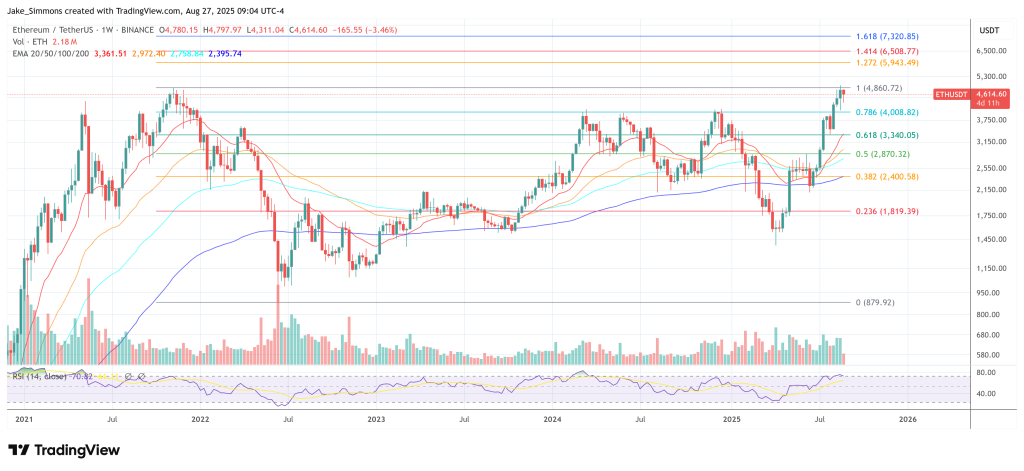Reasons to trust

Strict editing policy focusing on accuracy, relevance and fairness
Created by industry experts and meticulously reviewed
The highest standard for reporting and publishing
Strict editing policy focusing on accuracy, relevance and fairness
Morbi Pretium leo et nisl aliquam Mollis. Quisque Arcu Lorem, Ultricies Quis Pellentesque Nec, ullamcorper eu odio.
In an interview on August 26, FundStrat co-founder Tom Lee laid out a strong, policy-driven Ethereum Bull paper, claiming that it would set the stage for a fourth quarter rip, where US regulatory pivots, the transition to Wall Street’s on-chain infrastructure, and institutional demand routed through the public “Cryptocurrency Department.” “We should be getting $5,500 in the coming weeks soon,” Lee said, adding that ETH at the end of the year “should be closer to $10,000-$12,000.”
Ethereum’s “1971 Moment”
The brain behind Bitmine’s Eth Treasury Strategy 2025 frames the frame as a structural break comparable to the US dollar’s destruction from gold in 1971. In his view, Washington’s attitude shifted from viewing crypto as a threat to positioning it as a tool for financial leadership. “For the past 12 months, Crypto has undergone a shift in the ocean due to elections that are no longer considered an enemy, but it’s part of how the US financial system is leading,” Lee said.
He pointed out the “breakout product, you know, chat-GPT moment,” and the proposed act of genius and what he called the SEC’s “project code.”
Related readings
From there, Lee’s paper focuses on Ethereum as the default institutional settlement layer. “Wall Street doesn’t want the fastest chain. They want a reliable chain they can build. Ethereum has had zero downtime throughout history, so for me, it’s natural selection.”
Calling Ethereum the “fat protocol,” he argued that value arises in the fundamental layer as tokenization and payment rails move in chains. Citing the work “from mosaics and fund struts,” Lee said that if the network captures key payments and bank flows, it “reachs a network value of $60,000 per ETH” over a period of 10 to 15 years.
Bitmine’s strategy
A significant portion of the conversation focused on the public equity vehicle, which he chaired. Lee contrasted with owning a company that uses capital markets to expand ETH per share and holding spot ETH. “When Bitmine began, we only held Ethereum worth $4 per share,” he said of the July 8 baseline.
“As of August 24th, we have $39.84 worth of Ethereum per share. So the reason we’re holding 10 times more is because Bitmine uses the capital market and actively grows Ethereum per share by attracting institutional interest.”
He argued that this approach could be “anti-dial” when implemented at a stock premium against net asset value. Lee added that Bitmine has a $1 billion stock repurchase program because if the stock is too cheap compared to ETH holdings, it makes more sense to actually buy back the stock.”
Related readings
On strategy, Lee outlined his ambition to control about 5% of stained ETH, claiming the “power method” effect as a network importance scale. “For staking entities that own 5%, it will have a positive impact on future upgrades… (and) it’s one of the most important vectors for Wall Street when you want to build on Ethereum,” he said. The maintenance mechanics of Ethereum’s proofs made him argued that current holdings could generate substantial revenue. “At the $9 billion worth of ETH held today, that’s about $300 million in net profit.”
Tomley’s macro view
The institutional demand that Lee maintains is spinning towards ETH through regulated rappers and stocks, even though many large allocators still underweight it. “Ethereum is still not popular with institutions because most people bet on Bitcoin… so Ethereum is probably the most hated rally,” he said.
Lee’s macro overlays extend beyond ciphers. He repeated a constructive equity view conditioned on easing the Federal Reserve and periodic rise. “When the Fed continues to start cutting … and we get a drop in mortgage rates and ISM is showing up, so I think that’s why when the finances actually start to get involved, it’s about 6,800 in S&P,” he said. While acknowledging that “September is a month that everyone is worried about,” he characterized any pullbacks as available for purchase.
At the time of pressing, ETH traded for $4,614.

Featured images created with dall.e, charts on tradingview.com



